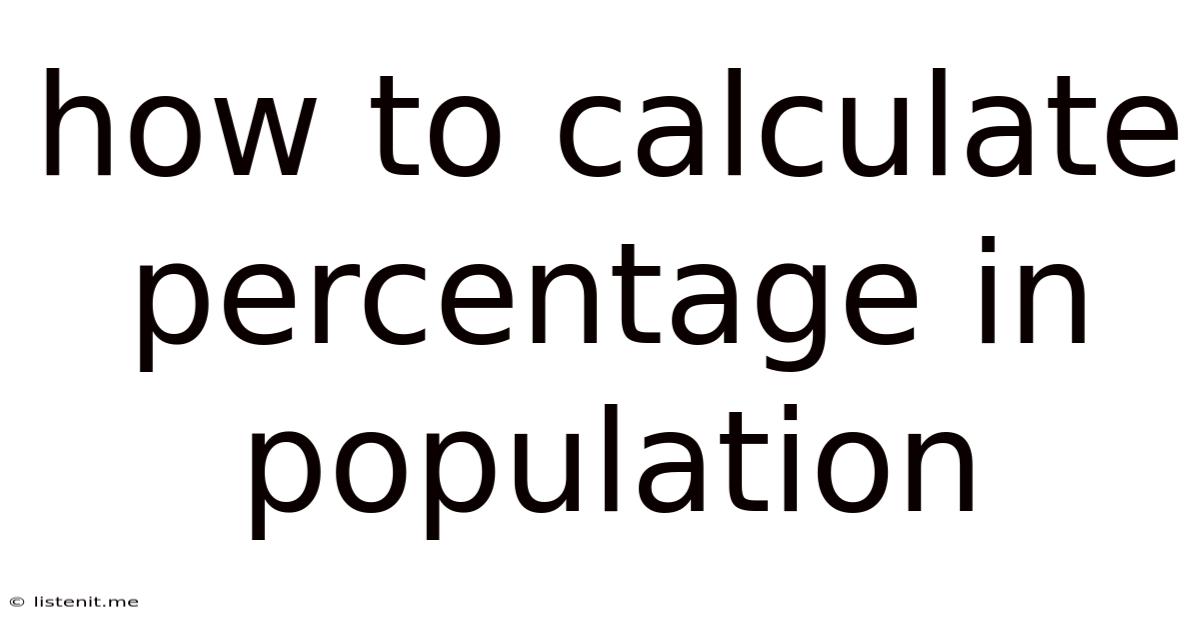How To Calculate Percentage In Population
listenit
May 26, 2025 · 4 min read

Table of Contents
How to Calculate Percentage in Population: A Comprehensive Guide
Calculating percentages within a population is a fundamental skill with wide-ranging applications, from understanding demographic shifts and election results to analyzing market research and assessing the prevalence of diseases. This comprehensive guide will walk you through various methods of calculating population percentages, offering practical examples and addressing common challenges.
Understanding the Basics of Percentage Calculation
Before diving into population-specific calculations, let's solidify our understanding of percentages. A percentage is simply a fraction expressed as a part of 100. The formula is:
(Part / Whole) x 100 = Percentage
For example, if 30 out of 100 people own a dog, the percentage of dog owners is (30/100) x 100 = 30%.
Calculating Simple Population Percentages
The simplest population percentage calculations involve a straightforward application of the basic percentage formula. Let's look at a few examples:
Example 1: Determining the Percentage of Women in a Population
Let's say a town has a population of 10,000, with 5,200 women. To calculate the percentage of women:
(5200 / 10000) x 100 = 52%
Therefore, 52% of the town's population is female.
Example 2: Calculating the Percentage of a Specific Age Group
Suppose a city has a population of 250,000, and 35,000 residents are between the ages of 25 and 34. To find the percentage of the population within this age range:
(35000 / 250000) x 100 = 14%
14% of the city's population falls within the 25-34 age group.
Example 3: Percentage Change in Population Over Time
Population percentages can also show growth or decline. Imagine a village with a population of 500 in 2020 and 600 in 2023. To calculate the percentage change:
- Find the difference: 600 - 500 = 100
- Divide the difference by the initial population: 100 / 500 = 0.2
- Multiply by 100 to express as a percentage: 0.2 x 100 = 20%
The village's population increased by 20% between 2020 and 2023. Remember to clearly state whether it's an increase or decrease.
Calculating More Complex Population Percentages
Real-world population data often requires more nuanced calculations. Let's explore some scenarios:
Example 4: Percentage Based on Multiple Subgroups
Consider a survey on preferred transportation methods. The results are:
- Car: 600 respondents
- Bus: 250 respondents
- Bike: 100 respondents
- Walk: 50 respondents
- Total: 1000 respondents
To calculate the percentage for each method:
- Car: (600 / 1000) x 100 = 60%
- Bus: (250 / 1000) x 100 = 25%
- Bike: (100 / 1000) x 100 = 10%
- Walk: (50 / 1000) x 100 = 5%
Example 5: Percentage within Stratified Populations
Sometimes, we need to calculate percentages within specific subgroups of a larger population. For example, imagine we have data on employment rates:
- Total Population: 15,000
- Employed: 10,500
- Unemployed: 4,500
- Male Population: 8,000
- Female Population: 7,000
To find the employment rate for males and females separately:
- Male Employment Rate: (Number of employed males / Total number of males) x 100 (This requires further data specifying the number of employed males)
- Female Employment Rate: (Number of employed females / Total number of females) x 100 (This requires further data specifying the number of employed females)
This highlights the importance of having detailed data for accurate stratified analysis.
Example 6: Using Percentages to Compare Populations
Percentages are invaluable for comparing different populations. For instance, let’s say we have data on the prevalence of a disease:
- Population A: 100,000 people; 5,000 cases of the disease
- Population B: 50,000 people; 2,000 cases of the disease
Calculating percentages reveals the disease prevalence:
- Population A: (5000 / 100000) x 100 = 5%
- Population B: (2000 / 50000) x 100 = 4%
Despite Population A having a larger number of cases, Population B has a higher prevalence rate.
Dealing with Complexities and Potential Errors
While percentage calculations are relatively straightforward, certain complexities can lead to errors.
- Sampling Bias: If your data comes from a non-representative sample, your percentages won't accurately reflect the entire population.
- Data Accuracy: Inaccurate or incomplete data will result in inaccurate percentages. Always check your data source's reliability.
- Misinterpreting Percentages: Avoid making misleading conclusions based solely on percentages. Consider the context, sample size, and potential biases.
Advanced Techniques and Tools
For large datasets, specialized software and statistical packages are invaluable. These tools can handle complex calculations, generate visualizations, and perform statistical tests to ensure the accuracy and reliability of your results. Examples include:
- Spreadsheet software (Excel, Google Sheets): These offer built-in functions for percentage calculations.
- Statistical software (R, SPSS, SAS): These provide more advanced statistical analysis capabilities for large datasets.
Conclusion
Calculating percentages within populations is a critical skill with vast applications in various fields. Understanding the basic principles and potential challenges, along with leveraging appropriate tools, ensures accurate and insightful analysis of population data. Remember to always consider the context, potential biases, and the reliability of your data source for robust and meaningful conclusions. By mastering these techniques, you can effectively analyze and interpret population data to draw informed conclusions and make data-driven decisions.
Latest Posts
Latest Posts
-
What Kind Of Info Does Ac Conductivity
May 27, 2025
-
Is Fist Grip A Power Grip
May 27, 2025
-
What Is In A Battery Charger
May 27, 2025
-
Human Muscles Have An Efficiency Of About
May 27, 2025
-
Ammonia Separating From N2 And H2
May 27, 2025
Related Post
Thank you for visiting our website which covers about How To Calculate Percentage In Population . We hope the information provided has been useful to you. Feel free to contact us if you have any questions or need further assistance. See you next time and don't miss to bookmark.